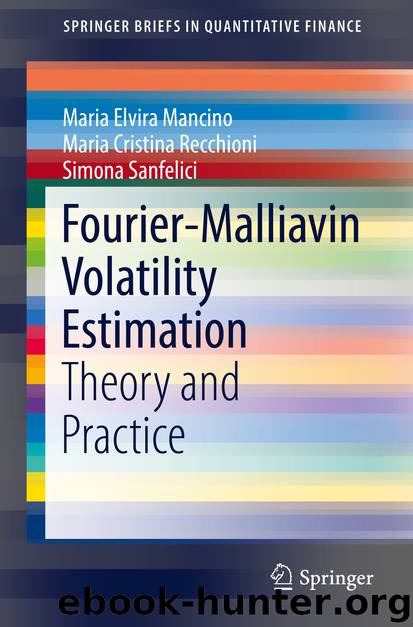Fourier-Malliavin Volatility Estimation by Maria Elvira Mancino Maria Cristina Recchioni & Simona Sanfelici

Author:Maria Elvira Mancino, Maria Cristina Recchioni & Simona Sanfelici
Language: eng
Format: epub
Publisher: Springer International Publishing, Cham
Fig. 5.6Fourier volatility estimate as a function of the maximum number of Fourier coefficients N from tick-by-tick data (blue line); Realized Volatility based on tick-by-tick data (red line); Realized Volatility based on 2-minute returns (black line).
5.3 The Case of Integrated Covariance
The estimation of multivariate volatilities is a challenging task for the combined effects of microstructure noises and asynchronous trading times. In fact, when considering intraday financial data, trades on different assets are not likely to occur at the same time. In such situations, the addition of a moderate amount of independent and uncorrelated noise may not have great effect on the estimates and it may in some cases even compensate the effects due to non-synchronicity. On the other side, Griffin and Oomen (2011) find that the ordering of covariance estimators in terms of efficiency depends crucially on the level of microstructure noise; in particular for high level of noise an estimator which is consistent for asynchronous observations, like (3.29), can become less efficient than the standard Realized Covariance.
This chapter starts with the finite sample properties of the Fourier covariance estimator in the presence of microstructure effects. Under a benchmark price model, we analytically compute the bias and the MSE for given finite sample sizes of the different assets and given number of Fourier coefficients included in the series. Under suitable growth conditions for these parameters, it is possible to prove that
• the bias of the Fourier estimator asymptotically vanishes,
• the MSE of the Fourier estimator converges to a constant.
As a consequence, even if we do not proceed to any bias-correction of the estimator, a suitable cutting of the highest frequencies makes the finite sample bias negligible. Moreover, we provide a practical way to optimize the finite sample performance of the Fourier estimator as a function of the number of frequencies by the minimization of the MSE, for a given number of intra-daily observations.
For simplicity, we consider the case of two assets. Assume the following model for the observed log-prices
Download
This site does not store any files on its server. We only index and link to content provided by other sites. Please contact the content providers to delete copyright contents if any and email us, we'll remove relevant links or contents immediately.
Modelling of Convective Heat and Mass Transfer in Rotating Flows by Igor V. Shevchuk(6392)
Weapons of Math Destruction by Cathy O'Neil(6152)
Factfulness: Ten Reasons We're Wrong About the World – and Why Things Are Better Than You Think by Hans Rosling(4696)
Descartes' Error by Antonio Damasio(3232)
A Mind For Numbers: How to Excel at Math and Science (Even If You Flunked Algebra) by Barbara Oakley(3223)
Factfulness_Ten Reasons We're Wrong About the World_and Why Things Are Better Than You Think by Hans Rosling(3200)
TCP IP by Todd Lammle(3137)
Fooled by Randomness: The Hidden Role of Chance in Life and in the Markets by Nassim Nicholas Taleb(3049)
Applied Predictive Modeling by Max Kuhn & Kjell Johnson(3019)
The Tyranny of Metrics by Jerry Z. Muller(3005)
The Book of Numbers by Peter Bentley(2913)
The Great Unknown by Marcus du Sautoy(2651)
Once Upon an Algorithm by Martin Erwig(2602)
Easy Algebra Step-by-Step by Sandra Luna McCune(2585)
Lady Luck by Kristen Ashley(2535)
Practical Guide To Principal Component Methods in R (Multivariate Analysis Book 2) by Alboukadel Kassambara(2497)
Police Exams Prep 2018-2019 by Kaplan Test Prep(2488)
All Things Reconsidered by Bill Thompson III(2358)
Linear Time-Invariant Systems, Behaviors and Modules by Ulrich Oberst & Martin Scheicher & Ingrid Scheicher(2334)
